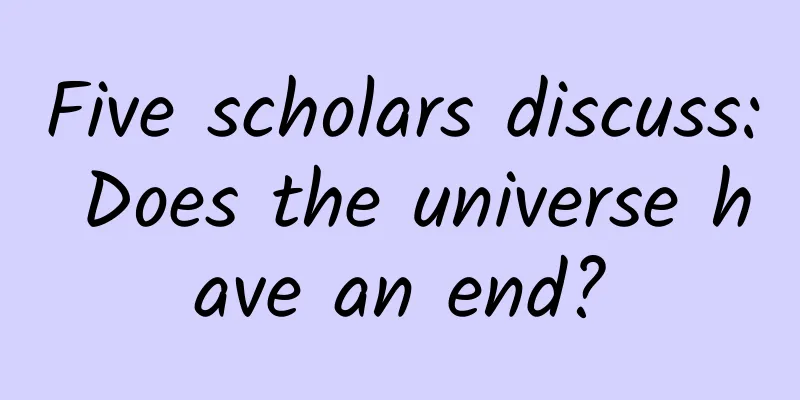Five scholars discuss: Does the universe have an end?

|
"Does the universe have an end? Does time have a length..." These questions from movie and TV lines are exactly what scientists are confused about. Is the universe infinite? We still cannot give a definite answer. Some physicists have proposed that the geometric shape of the universe is a closed donut, and therefore believe that the universe is finite. Other scholars believe in the concept of rapid inflation, and we can only understand the concepts of matter and existence in the observable universe. In this article, five scholars, including astronomers, philosophers of science, and historians of science, give their own ideas on whether the universe is infinite. By Noor Gillani Compiled by Tian Fang We already know that the universe is expanding, but research in recent years has found that the expansion rate is much faster than we expected. Despite great breakthroughs in telescope and satellite technology, it is believed that there are still many things in the universe that are far beyond our sight, beyond the so-called observable universe. This also means that we are not sure yet what the shape of the entire universe is - is it a closed cosmic "doughnut", a plane that stretches like an infinitely large piece of paper, or a huge sphere that is constantly expanding? Cosmologists often refer to doughnuts without edges and vertices - torus-like structures. Toruses are important mathematical structures. Scientists want to understand where space ends and what it might be like there. What do they think about the fate of the universe, and will it expand forever? We spoke to five scientists, and it seems like there's no definitive answer yet. Here are their answers. Anna Moore (Professor at the Space Institute of the Australian National University and astronomer): Maybe The short answer is, "We don't know if the Universe is finite or not." We know that the observable Universe -- the part we can clearly see and measure -- began in the Big Bang 13.8 billion years ago. So we know that the Universe is finite, at least as old as the Big Bang. But the Universe is getting bigger and bigger. It's been expanding in all directions since the Big Bang, and it's still expanding (and lately, at an increasing rate). The remnant radiation from the Big Bang, called the cosmic microwave background, represents the earliest image of a smaller, hotter, and denser universe. We can understand the shape (or geometry) of the largest-scale universe from the early images. Knowing this is important for understanding whether the universe is infinite or finite. Satellite detection results show that the universe has a flat geometric shape. In a flat universe, two beams of light shot into space side by side will always remain parallel, never intersecting or moving away. In this way, we can still regard a cylindrical or torus (donut) shaped universe as "flat". Current detection technology is not precise enough to tell us whether the flat geometry of the Universe can be represented by a piece of paper, a cylinder, a torus, or any other structure that allows two beams of light to pass through in parallel. An infinite Universe could be a flat geometry like a piece of paper that would stretch forever and contain all possibilities, such as infinite versions of ourselves. On the other hand, a donut-shaped Universe would have to be finite because it is closed. But as of yet, we still don't know the shape of the Universe, nor its size. Sara Webb (PhD student in astrophysics at Swinburne University of Technology): Yes. I believe the universe is infinite. We know that the universe began with the Big Bang. From observation, we don't know where it began, but the Big Bang happened. No matter where you are in the universe (in the Milky Way or far away), the universe is expanding in all directions from you. Now we calculate that the universe is about 13.8 billion years old, which means it has expanded a lot. So logically, we can estimate the radius of the universe to be 13.8 billion light years, right? But the radius of the observable universe is actually 46 billion light years, which means that the first light we can see (380,000 years after the Big Bang) came from a distance of 46 billion light years away. This is due to so-called "rapid inflation". However, there is no reason to think that the edge of the observable universe is the edge of the actual universe. We tend to think of things as having three-dimensional shapes, like spheres, cubes, or cones. We can imagine the universe as a sphere that expands infinitely. Or it could be curved in a way that makes it a closed system (a donut), where you can travel far enough in a straight line and eventually end up back where you started - the universe is finite. But I lean towards another possibility, which is inflation after the Big Bang. There is a theory that inflation is actually eternal inflation, which means it is always happening here or there, making the universe infinite. This requires delving into theories as unimaginable as quantum fluctuations or even the multiverse. As a science fiction lover, how could I not hope it is true? Tanya Hill (Honorary Research Fellow, University of Melbourne, Senior Curator, Museums Victoria, Astronomer): Yes. The universe we can see is finite. The observable universe is finite, and it won't last forever. It stretches out to 46 billion light-years around us (although our universe is 13.8 billion years old, and the observable universe is much wider as the universe is expanding). The observable universe is centered on us. Aliens in distant galaxies could also have observable universes centered on themselves. While there may be some overlap between these observable universes at different centers, there will inevitably be some regions that we cannot see. Therefore, it is impossible to say whether the universe is finite because we cannot see it in its entirety. Instead, we solve this problem by exploring the shape of the universe. Although we don't know the shape of the entire universe, we know that the part of the universe centered on us is flat. This means that two rockets flying in parallel on cruise control will always remain parallel. Because space does not curve, the rockets will never meet or fly away from each other. A flat universe could be infinite, like a two-dimensional sheet of paper that stretches forever. But it could also be finite, like forming a cylinder out of a sheet of paper and joining the two ends to form a donut. That's the problem. Furthermore, there are many ways that the universe could be curved, but we live in a flat region. This is a very special case, and we use the theory of "inflation" to explain it. Inflation is the rapid expansion of the universe for a short period of time at a very early time, which explains all the kinks and curvatures in our space. After the inflationary phase, the universe became what we see today. But inflation may not only have an effect on our universe, maybe it happened somewhere else, and it is happening now. How big does this make the entire universe, or even the multiverse, even bigger? It opens up some possibilities, in my opinion, that infinite universes are easier to imagine than finite ones. Sam Baron (Associate Professor, Australian Catholic University, philosopher of science): No. There is a conventional view that assumes that space is infinite, but I think this is wrong. It goes something like this: If the universe is finite, then it must have an edge. But imagine flying a spaceship far out into the universe and discovering the edge of the universe. That would be incredible - what would the edge look like? Therefore, the universe must go on forever. But there are other ways that space could be finite. It could be a torus, which is spatially finite but has no edge, like a cosmic donut. If the universe is donut-shaped, then there's a very scientific test to see if the universe is finite. Suppose you aim a beam of light at a very distant reflective surface. If the surface is not flat, the light will be reflected in many directions. If the universe is donut-shaped, the reflected light will gradually bend along the shape of the universe, eventually circling back and intersecting (as shown in the figure below). This only happens if the universe is finite. In an infinite universe, light will propagate infinitely. Now imagine you're standing where the rays intersect. You turn and see the object that reflected the light; if you turn the other way, you see the same object, but the light comes from a different angle. If the reflector is a distant planet, you can see the same planet twice. Scientists have begun looking for this hall of mirrors effect in the dim light left over from the Big Bang. It may provide evidence of the size and shape of the universe. Nothing has been found that is definitive yet, but who knows what we can uncover as we keep exploring? A test to see if space is finite: if we reflect light from an object, we see the reflection twice; then the space we live in is probably finite and curved! Kevin Orrman-Rossiter (PhD candidate in History and Philosophy of Science, University of Melbourne): No When we talk about "infinity", we usually mean something that is boundless or endless. My point is that the universe is finite. To prove this point, let's temporarily assume that the universe is infinite. A very simple example is that I take a spaceship and set off in any direction, and I will never reach the boundary. But there is a problem with this experiment: I may need to fly for an infinite amount of time to ensure that there is no boundary "a little further away", and it doesn't matter what speed I travel at. In order to prove the hypothesis that the empty universe is infinite, my voyage needs to be infinite. Obviously, not many institutions are willing to fund such an experiment at present. This shows that in order to prove that the Universe is infinite, we must rely on observations rather than direct experiments. Over the last century, we have learned a lot about the Universe through observations. We know that the Universe began about 13.8 billion years ago. From observations, we also know that the Universe is expanding. We have detected microwave background radiation - thought to be leftover radiation from the Big Bang. The Universe we see today is a slowly expanding web of galaxies. A key question in cosmology is whether this expansion will continue, whether it will change speed, or whether it can be reversed. Answering this question requires understanding the properties of dark matter and dark energy. An interesting point is that, whatever the model of the universe is (and there is still something very important missing here), current cosmological thinking is that the universe will have an end, it will not exist forever. The universe has a finite existence in time, which goes back to my argument that I suggest that our space travel should end at some stage. References 1. https://www.space.com/33892-cosmic-microwave-background.html 2. https://www.quantamagazine.org/what-shape-is-the-universe-closed-or-flat-20191104 3. https://www.forbes.com/sites/startswithabang/2017/10/14/ask-ethan-is-the-universe-finite-or-infinite/?sh=7429ea2d4967 4. https://www.space.com/31465-is-our-universe-just-one-of-many-in-a-multiverse.html 5. https://www.nature.com/articles/news.2008.854 6. https://www.newscientist.com/article/dn4250-tantalising-evidence-hints-universe-is-finite/ 7. https://press.princeton.edu/books/hardcover/9780691196022/cosmology-century More than 70 of the universe is made of dark energy, the mysterious stuff, even stranger than dark matter |
<<: Prevent cervical spondylosis from daily life!
Recommend
Audi's first pure electric SUV e-tron will be launched next year, a major innovation to change the bad habit of false labeling in the electric vehicle market
In the chess game of new energy vehicles in China...
KEEP product analysis
During the Spring Festival, Keep Live Class launc...
Foreigners' View on China's Mobile App UI Design Trends
This summer, due to work reasons, I moved from Sa...
Apple and Samsung's market share has both declined. Why are domestic mobile phones rising?
In the first quarter of this year, Apple and Sams...
If you don't lose weight in spring, you will regret it in summer? The secret of healthy and fast weight loss is revealed!
Review expert: Peng Guoqiu, deputy chief physicia...
KOL Marketing: Xiaohongshu’s High-Quality Short Video Influencer Screening Guide
At present, short videos, as a dark horse in traf...
Practical tips: To improve SMS marketing ROI, these three aspects are the key
Based on his own practice, the author shares rele...
Why are some dreams always so strange? Maybe it has something to do with it…
Alice chases a rabbit with a pocket watch and ent...
Pain level 10! Have you heard of "snake around the waist"?
Let me ask you a question first. Have you ever he...
Nature: The secret of crying? Babies cry → mothers release oxytocin | World Breastfeeding Week
Support breastfeeding and build a beautiful child...
Can Venus Flytraps catch flies? What misunderstandings do you have about carnivorous plants?
"Tropical Life, Beautiful Yearning" - &...
Analysis of Internet Financial Product Operation Strategy
The main product model of Internet finance is rel...
What should I write in the copy? Share 4 points!
Of course I know that when writing copy , one sho...
A comprehensive analysis of Tmall’s Double 11 e-commerce operations in 2021
Starting from 2019, Double Eleven no longer refer...
Android Kugou Music v9.9.2.0 unlocks some functions_Taoduoduo
Remove ads, remove upgrades, streamline some butt...









